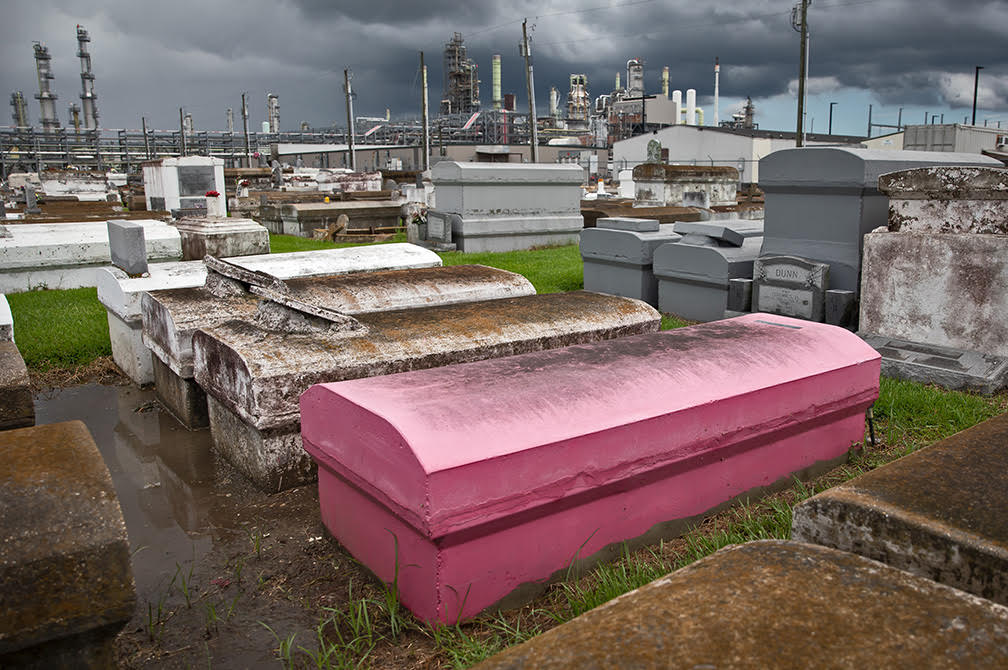
Roller Coaster Ride in the Atlantic is a striking and apt image for this moment: a twisting metal hull of a structure built for human enjoyment awash in the waves of a careless ocean. The photograph— by Louisiana’s Julie Dermanksy— is also befitting for this tumultuous year. As we ride the coaster’s rails, the ups and downs, the twists and turns, the terror and exhilaration are all overshadowed by the sense that we’re underwater.
In their exhibition These Last Days Of Now, Dermanksy and Michel Varisco offer a glimpse from the shore of a world slipping beneath a rising tide caused by a warming planet.
Varisco’s series literally dives into the subject. Through eerie, ethereal underwater portraits printed on aluminum, she builds a new natural world with people who seem to comfortably, if not nobly, inhabit the liminal space between “no longer,” “not yet,” and the “eternal now.” They appear as natural as the submerged tree trunks and eel grasses surrounding them—perhaps a commentary on both the remarkability and the tragic necessity of human adaptation.
“I’m asking people to come underwater with me and let’s start creating this thalassic colony because nobody is changing the direction of climate change in a large enough way that it won’t be otherwise,” Varisco said. “So I’m fast-forwarding and using magical realism.”
The magic is the watery landscape of the future. The realism is the people, all of whom have been directly impacted by the very real effects of today’s changing climate.

In Alert, the subject to the left is a man named Chris Gang, whose community in the southern coal fields of West Virginia was affected by a chemical spill. He was part of a mutual aid project focused on providing clean water access. Each of the subjects has their own story to tell from their underwater abodes.
“The idea of this show is to bring some of the reality of Julie’s photographs and fast-forwarding into an imaginary world that I’m showing,” said Varisco.
The pair met while they were both covering the BP oil spill in 2010. But there too, they translated what they were seeing in different ways. Varisco designed and built installations people could walk through, their movements affecting the shape and the way they perceived the piece to represent the impacts of the spill symbolically. Dermansky documented the spill extensively through her photojournalism.

As you move through the small gallery with Varisco’s scenes adorning the sparse walls, the back room is filled with Dermansky’s photography also printed on metal. Here, there is no magical realism, there is only stark reality. With titles like Playground next to TPC Plant After Explosion in Texas or Waffle House in Florida After Hurricane Michael, Dermansky doesn’t add any extra fluff, flair, or filter. With a touch of “irony and through intensely uncomfortable juxtapositions,” she illustrates the effects of a changing climate and the forces that aid and abet it. Her images are raw and evidentiary.
“I want to know. I want to see it for myself,” Dermansky said of her work. “If I’m out there and sharing what I’m seeing, then I’m doing something.”
Even in its limited run, the gallery was nearly forced to close by two hurricanes, an appropriate irony. Fortunately, Varisco and Dermansky were prepared for it. It’s part of the reason they chose to print their images on metal—they’re waterproof.
You can bear witness and view their work by moving through the exhibition in a virtual gallery here.
To see more of Julie Dermansky’s work, you can find her website here.
For more of Michel Varisco’s work, visit her website here.
